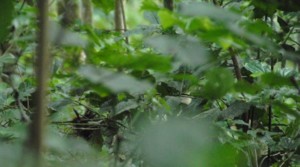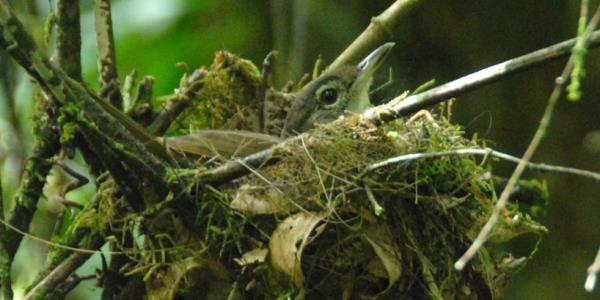LINKED PAPER
Flexible nest‐site selection under anthropogenic habitat change in an Afrotropical understorey insectivore. Van de Loock, D., Strubbe, D., Thijs, K.W., Van De Peer, T., De Neve, L., Githiru, M., Matthysen, E. & Lens, L. 2019. IBIS. DOI: 10.1111/ibi.12691. VIEW
Have you ever wondered why your bird house does not attract any birds? I did some weeks ago, just before spring arrived. One morning I woke up to the chitter and chatter of Great Tits (Parus major) inspecting one of our nest boxes and was thrilled by the foresight of having a couple in my garden. Weeks passed by however without any signs of the birds. I wondered why and realised that the couple may have changed their mind due to the removal of one my neighbours’ small trees. That tree happened to be the perfect ‘approach route’ for the couple, as it provided cover upon returning from feeding forays to the nest box. Without that tree, the couple could not safely approach their nest, and therefore discarded my nest box.
Just as in my back yard, birds from every corner of the globe need to cope with human-induced changes in their environment. When occurring on a large scale (larger than one’s garden), environmental changes may influence the nesting behaviour of species and affect the long-term viability of the population. To demonstrate this, we travel from our neat British garden to the chaotic understory of a large rainforest. The birds that inhabit these rain forests have over evolutionary time gradually learned the most suitable sites for nesting. They know which features in the understory to look for when constructing a nest to produce a most successful brood. But, due to anthropogenic habitat change they may fail to find such areas. Or, even worse, they may nest at sites which are thought to be good but have actually become dangerous.
Particularly in tropical rainforests, we know little about the influence of habitat change on nesting behaviour of birds. Tropical forests worldwide are under severe pressure from increasing agricultural practices, just as in the lush Taita Hills of South-east Kenya. Most of the indigenous cloud forest of these Hills is lost. What remains is confined to differently sized fragments that are scattered across the landscape and are all further degraded from selective logging. The Placid Greenbul (Phyllastrephus placidus) is a medium-sized bird and a common sight in the forest interior of most of these remnant fragments, which makes it possible to compare nesting behaviour between different fragments that vary in level of forest degradation.

Figure 1 The landscape of the lush, rolling Taita Hills in South-east Kenya is dominated by small-subsistence agriculture at the cost of forest loss and disturbance. Left-over indigenous cloud forest fragments are scattered across the Hills with scissor cut abrupt edges (right)
Placid Greenbuls appear to use a flexible nesting strategy in this landscape, as birds from differently degraded forest fragments show both differences and similarities in the area they prefer for nesting. In either forest fragment, they prefer very dense areas with little woody debris in the surrounding area. These are measures to reduce the probability of losing a brood to a predator, which is the principle cause of nest failure in this species. This species constructs simple, open-cup shape nests at a height of about 1.5 m in the fork of a climber, bush or small tree. Hence, a thick, dense foliage cover around a nest acts as a barrier against predators. Predators will have a harder time to find the nests as it is visually secluded, and because the transfer of both sounds and smells produced by the nestlings are blocked. Dead wood on the other hand shelters many potential nest predators such as snakes and shrews. Areas with fewer dead wood simply contain fewer predators.

Figure 2 Forest degradation by felling large trees opens up the canopy, allowing the sun to penetrate deeper into the forest interior. Understory plants proliferate under such abundant light conditions (left photo). A more closed canopy and open understory is characteristic for more pristine forest conditions (right photo)
But among these different forest fragments, greenbuls also vary in the areas used for nesting. This may be an indirect consequence of variation in forest structure, for instance when the structure and growth of climbers became dramatically altered in a highly degraded forest. Yet, it is also possible that birds actively response to variation in environmental conditions, for instance to cope with novel situations. In more pristine forest, greenbuls like to nest in areas with tall trees. Areas with uncut giants probably characterise the least disturbed patches of forest. Also, birds show aversion to nest near edge habitat as these sites may receive negative influences from outside the forest. Such patterns were not detected in less pristine forest because tall trees were usually planted exotics, and because there is less contrast between edge and interior habitat in heavily degraded forest.

Figure 3 Open-cup nesting birds, such as the Placid Greenbul (Phyllastrephus placidus), construct their nest at well-secluded sites to avoid being detected by predators. Can you spot the nest and incubating bird?
Even though birds prefer to nest at specific areas in both forest fragments, such strategy is not associated with an increased nest success. Couples that construct their nests at preferred and avoided areas in either forest fragments suffer equally from nest predation. Failure to detect a relationship between nest-site choice and success happens often in such studies. One plausible explanation may be that birds use information on the density of predators in the area to decide on a nesting spot, a parameter which we did not include in our analysis. As many of these predators are elusive animals that are challenging to observe, we currently know too little about the community that predate on this, as well as on many other, tropical bird species. As it stands, we only gradually gain a better understanding in the complex relationships that occur in tropical ecosystems and look forward to lay more pieces of the this beautiful puzzle. All in all, it is hopeful to observe that birds in more degraded cloud forest do not appear to be making worse decisions than their conspecifics in more pristine forest on where to build their nest.
Nominate this article for a BOU Science Communication Award.
References
Van de Loock, D., Strubbe, D., Thijs, K.W., Van De Peer, T., De Neve, L., Githiru, M., Matthysen, E. & Lens, L. 2019. Flexible nest‐site selection under anthropogenic habitat change in an Afrotropical understorey insectivore. IBIS. DOI: 10.1111/ibi.12691. VIEW
Image credits
Featured image: Placid Greenbul Phyllastrephus placidus female incubating on an open-cup nest in the understory © Dries Van de Loock




